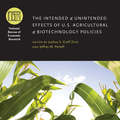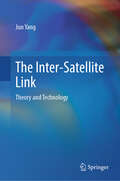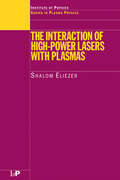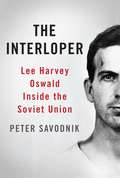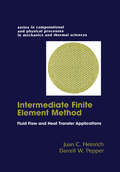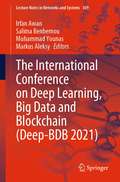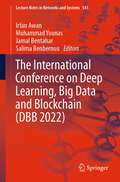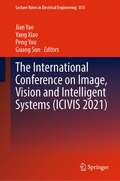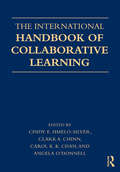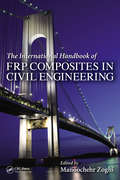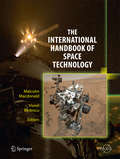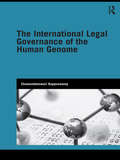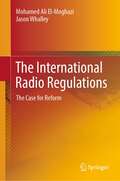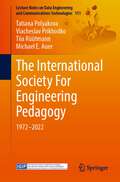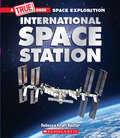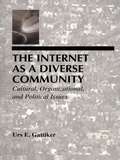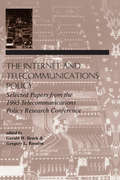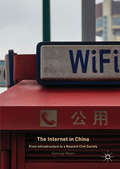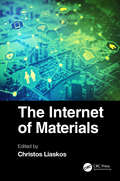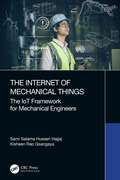- Table View
- List View
The Intended and Unintended Effects of U.S. Agricultural and Biotechnology Policies
by Joshua S. Graff Zivin Jeffrey M. PerloffUsing economic models and empirical analysis, this volume examines a wide range of agricultural and biofuel policy issues and their effects on American agricultural and related agrarian insurance markets. Beginning with a look at the distribution of funds by insurance programs--created to support farmers but often benefiting crop processors instead--the book then examines the demand for biofuel and the effects of biofuel policies on agricultural price uncertainty. Also discussed are genetically engineered crops, which are assuming an increasingly important role in arbitrating tensions between energy production, environmental protection, and the global food supply. Other contributions discuss the major effects of genetic engineering on worldwide food markets. By addressing some of the most challenging topics at the intersection of agriculture and biotechnology, this volume informs crucial debates.
The Intended and Unintended Effects of U.S. Agricultural and Biotechnology Policies: Intended And Unintended Effects Of U. S. Agricultural And Biotechnology Policies (National Bureau of Economic Research Conference Report)
by Joshua S. Graff Zivin Jeffrey M. PerloffUsing economic models and empirical analysis, this volume examines a wide range of agricultural and biofuel policy issues and their effects on American agricultural and related agrarian insurance markets. Beginning with a look at the distribution of funds by insurance programs—created to support farmers but often benefiting crop processors instead—the book then examines the demand for biofuel and the effects of biofuel policies on agricultural price uncertainty. Also discussed are genetically engineered crops, which are assuming an increasingly important role in arbitrating tensions between energy production, environmental protection, and the global food supply. Other contributions discuss the major effects of genetic engineering on worldwide food markets. By addressing some of the most challenging topics at the intersection of agriculture and biotechnology, this volume informs crucial debates.
The Inter-Satellite Link: Theory and Technology
by Jun YangThis book highlights a comprehensive coverage of the science and technology of multi-orbit inter-satellite links. It describes the fundamental concepts and system requirements, presents the architecture and measurement principles and demonstrates the anti-interference design, access and slot planning, network transmission and routing, calibration and test evaluation, as well as applications for measurement and communication. Recent advances in theoretical research on precision measurement and communication are presented. The book serves as a reference for professionals involved in designing space-based information systems or developing satellite-ground equipment or services based on inter-satellite links. Additionally, it is also a valuable resource for teachers and graduate students in related majors.
The Interaction of High-Power Lasers with Plasmas (Series in Plasma Physics)
by Shalom EliezerThe Interaction of High-Power Lasers with Plasmas provides a thorough self-contained discussion of the physical processes occurring in laser-plasma interactions, including a detailed review of the relevant plasma and laser physics. The book analyzes laser absorption and propagation, electron transport, and the relevant plasma waves in detail. It al
The Interloper: Lee Harvey Oswald Inside the Soviet Union
by Peter SavodnikLee Harvey Oswald’s assassination of President Kennedy in 1963 remains one of the most horrifying and hotly debated crimes in American history. Just as perplexing as the assassination is the assassin himself; the 24-year-old Oswald’s hazy background and motivations#151;and his subsequent murder at the hands of Jack Ruby#151;make him an intriguing yet frustratingly enigmatic figure. Because Oswald briefly defected to the Soviet Union, some historians allege he was a Soviet agent. But as Peter Savodnik shows in The Interloper, Oswald’s time in the U. S. S. R. reveals a stranger, more chilling story. Oswald ventured to Russia at the age of 19, after a failed stint in the U. S. Marine Corps and a childhood spent shuffling from address to address with his unstable, needy mother. Like many of his generation, Oswald struggled for a sense of belonging in postwar American society, which could be materialistic, atomized, and alienating. The Soviet Union, with its promise of collectivism and camaraderie, seemed to offer an alternative. While traveling in Europe, Oswald slipped across the Soviet border, soon settling in Minsk where he worked at a radio and television factory. But Oswald quickly became just as disillusioned with his adopted country as he had been with the United States. He spoke very little Russian, had difficulty adapting to the culture of his new home, and found few trustworthy friends; indeed most, it became clear, were informing on him to the KGB. After nearly three years, Oswald returned to America feeling utterly defeated and more alone than ever#151;and as Savodnik shows, he began to look for an outlet for his frustration and rage. Drawing on groundbreaking research, including interviews with Oswald’s friends and acquaintances in Russia and the United States, The Interloper brilliantly evokes the shattered psyche not just of Oswald himself, but also of the era he so tragically defined.
The Intermediate Finite Element Method: Fluid Flow And Heat Transfer Applications (Series In Computational Methods And Physical Processes In Mechanics And Thermal Sciences Ser.)
by Darrell W. Pepper Juan C. HeinrichThis book is a follow-up to the introductory text written by the same authors. The primary emphasis on this book is linear and nonlinear partial differential equations with particular concentration on the equations of viscous fluid motion. Each chapter describes a particular application of the finite element method and illustrates the concepts through example problems. A comprehensive appendix lists computer codes for 2-D fluid flow and two 3-D transient codes.
The International African Library: Zimbabwe's Migrants and South Africa's Border Farms
by Maxim BoltDuring the Zimbabwean crisis, millions crossed through the apartheid-era border fence, searching for ways to make ends meet. Maxim Bolt explores the lives of Zimbabwean migrant labourers, of settled black farm workers and their dependants, and of white farmers and managers, as they intersect on the border between Zimbabwe and South Africa. Focusing on one farm, this book investigates the role of a hub of wage labour in a place of crisis. A close ethnographic study, it addresses the complex, shifting labour and life conditions in northern South Africa's agricultural borderlands. Underlying these challenges are the Zimbabwean political and economic crisis of the 2000s and the intensified pressures on commercial agriculture in South Africa following market liberalization and post-apartheid land reform. But, amidst uncertainty, farmers and farm workers strive for stability. The farms on South Africa's margins are centers of gravity, islands of residential labour in a sea of informal arrangements.
The International Conference on Deep Learning, Big Data and Blockchain (Lecture Notes in Networks and Systems #309)
by Muhammad Younas Irfan Awan Markus Aleksy Salima BenbernouThe role of deep learning for the analysis and learning of massive amounts of data from all aspects of daily-life has dramatically changed over the last few years. It is increasingly helping uncover trends leading to great successes. This book includes a collection of research manuscripts presenting state-of-the-art work in the areas of deep learning, blockchain and big data. All the manuscripts included in this book have been peer-reviewed based on aspects of novelty, originality and rigour. The main topics covered in the book include machine learning and time series, blockchain technologies and applications, data security, deep learning, and Internet of Things.
The International Conference on Deep Learning, Big Data and Blockchain (Lecture Notes in Networks and Systems #541)
by Muhammad Younas Irfan Awan Salima Benbernou Jamal BentaharDeep and machine learning is the state-of-the-art at providing models, methods, tools and techniques for developing autonomous and intelligent systems which can revolutionise industrial and commercial applications in various fields such as online commerce, intelligent transportation, healthcare and medicine, etc. The ground-breaking technology of blockchain also enables decentralisation, immutability, and transparency of data and applications. This event aims to enable synergy between these areas and provide a leading forum for researchers, developers, practitioners, and professionals from public sectors and industries to meet and share the latest solutions and ideas in solving cutting-edge problems in the modern information society and the economy. The conference focuses on specific challenges in deep (and machine) learning, big data and blockchain. Some of the key topics of interest include (but are not limited to): Deep/Machine learning based models Statistical models and learning Data analysis, insights and hidden pattern Data visualisation Security threat detection Data classification and clustering Blockchain security and trust Blockchain data management
The International Conference on Image, Vision and Intelligent Systems (Lecture Notes in Electrical Engineering #813)
by Yang Xiao Jian Yao Peng You Guang SunThis book is a collection of the papers accepted by the ICIVIS 2021—The International Conference on Image, Vision and Intelligent Systems held on June 15–17, 2021, in Changsha, China. The topics focus but are not limited to image, vision and intelligent systems. Each part can be used as an excellent reference by industry practitioners, university faculties, research fellows and undergraduates as well as graduate students who need to build a knowledge base of the most current advances and state-of-practice in the topics covered by this conference proceedings.
The International Handbook of Collaborative Learning (Educational Psychology Handbook)
by Cindy E. Hmelo-Silver Clark A. Chinn Carol K. K. Chan Angela M. O’DonnellCollaborative learning has become an increasingly important part of education, but the research supporting it is distributed across a wide variety of fields including social, cognitive, developmental, and educational psychology, instructional design, the learning sciences, educational technology, socio-cultural studies, and computer-supported collaborative learning. The goal of this book is to integrate theory and research across these diverse fields of study and, thereby, to forward our understanding of collaborative learning and its instructional applications. The book is structured into the following 4 sections: 1) Theoretical Foundations 2) Research Methodologies 3) Instructional Approaches and Issues and 4) Technology. Key features include the following: Comprehensive and Global – This is the first book to provide a comprehensive review of the widely scattered research on collaborative learning including the contributions of many international authors. Cross disciplinary – The field of collaborative learning is highly interdisciplinary drawing scholars from psychology, computer science, mathematics education, science education, and educational technology. Within psychology, the book brings together perspectives from cognitive, social, and developmental psychology as well as from the cross-disciplinary field of the learning sciences. Chapter Structure – To ensure consistency across the book, authors have organized their chapters around integrative themes and issues. Each chapter author summarizes the accumulated literature related to their chapter topic and identifies the strengths and weaknesses of the supporting evidence. Strong Methodology – Each chapter within the extensive methodology section describes a specific methodology, its underlying assumptions, and provide examples of its application. This book is appropriate for researchers and graduate level instructors in educational psychology, learning sciences, cognitive psychology, social psychology, computer science, educational technology, teacher education and the academic libraries serving them. It is also appropriate as a graduate level textbook in collaborative learning, computer-supported collaborative learning, cognition and instruction, educational technology, and learning sciences.
The International Handbook of FRP Composites in Civil Engineering
by Manoochehr ZoghiThe use of high-performance fiber reinforced polymer (FRP) composite materials has expanded beyond the aerospace and marine industries, into civil engineering and related disciplines. This handbook provides a complete primer on FRP composites, including materials, manufacturing, life-cycle costs, and mechanics. It also focuses on professional applications, such as hybrid FRP composite systems, composites for reinforcement, nondestructive testing and evaluation, and design philosophies and guidelines. It includes standards of practice from around the world, as well as helpful design charts, formulas, and tables for easy reference.
The International Handbook of Space Technology
by Malcolm Macdonald Viorel BadescuThis comprehensive handbook provides an overview of space technology and a holistic understanding of the system-of-systems that is a modern spacecraft. With a foreword by Elon Musk, CEO and CTO of SpaceX, and contributions from globally leading agency experts from NASA, ESA, JAXA, and CNES, as well as European and North American academics and industrialists, this handbook, as well as giving an interdisciplinary overview, offers, through individual self-contained chapters, more detailed understanding of specific fields, ranging through: · Launch systems, structures, power, thermal, communications, propulsion, and software, to · entry, descent and landing, ground segment, robotics, and data systems, to · technology management, legal and regulatory issues, and project management. This handbook is an equally invaluable asset to those on a career path towards the space industry as it is to those already within the industry.
The International Law of Disaster Relief
by Michael J. Kelly David D. Caron Michael J. Kelly Anastasia Telesetsky David D. CaronDisasters can strike often and with unexpected fury, resulting in devastating consequences for local populations that are insufficiently prepared and largely dependent upon foreign aid in the wake of such catastrophes. International law can play a significant role in the recovery after inevitable natural disasters; however, without clear legal frameworks, aid may be stopped, delayed, or even hijacked - placing the intended suffering recipients in critical condition. This edited volume brings together experts, emerging scholars, and practitioners in the field of international disaster law from North America, Japan, New Zealand, and Australia to analyze the evolution of international disaster law as a field that encompasses new ideas about human rights, sovereignty, and technology. Chapters focus on specific natural disasters like Hurricane Katrina, Cyclone Nargis, and Typhoon Hainan in addition to volcanic and earthquake activity, wildfires, and desertification. This book begins a dialogue on the profound implications of the evolution of international law as a tool for disaster response.
The International Legal Governance of the Human Genome (Genetics and Society)
by Chamundeeswari KuppuswamyThe human genome is a well known symbol of scientific and technological progress in the twenty-first century. However, concerns about the exacerbation of inequalities between the rich and the poor, the developing and the developed states, the healthy and the unhealthy are causing problems for the progress of scientific research. The international community is moving towards a human rights approach in addressing these concerns. Such an approach will be piecemeal and ineffective so long as fundamental issues about economic, social and cultural rights, the so-called second generation of human rights, are not addressed. This book argues that, in order to be able to meaningfully apply a human rights framework to the governance of the human genome, the international human rights framework should be based on a unified theory of human rights where the distinction between positive and negative rights is set aside. The book constructs a common heritage concept with the right to development at its core and explores the content of the right to development through rational human rights theory. It is argued that the notion of property rights in the human genome should be placed within the context of protecting human rights, including the right to development. The concept of common heritage of humanity, contrary to the widely held belief that it is in opposition to patenting of gene sequences, supports human rights-based conceptions of property rights. This book fills a gap in the literature on international legal governance of the human genome will provide an essential reference point for research into the right to development, development issues in bioethics, the role of international institutions in law making and research governance.
The International Political Economy of Oil and Gas
by Slawomir RaszewskiThis book addresses energy research from four distinct International Political Economy perspectives: energy security, governance, legal and developmental areas. Energy is too important to be neglected by political scientists. Yet, within the mainstream of the discipline energy research still remains a peripheral area of academic enquiry seeking to plug into the discipline's theoretical debates. The purpose of this book is to assess how existing perspectives fit with our understanding of social science energy research by focusing on the oil and gas dimension.
The International Radio Regulations: The Case for Reform
by Jason Whalley Mohamed Ali El-MoghaziThis book provides an in-depth introduction to the International Telecommunication Union (ITU) Radio Regulations (RR) and the policies that govern them. Established in 1906, these regulations define the allocation of different frequency bands to different radio services, the mandatory technical parameters to be observed by radio stations, especially transmitters, and the procedures for spectrum use coordination at the international level. The book analyzes the interactions between different national policies and the ITU RR, noting how these interactions influence spectrum policy on the national level, setting up a comparative framework within which to view these regulations and their effects. Beginning with an overview of the history of the origins ITU RR, the book takes a deep dive into the components of spectrum management including radio communication service allocation, wireless technology selection, radio usage rights, and spectrum rights assignment, placing each analysis within the context of the push and pull between national and international regulations. The book concludes with chapters discussing issues affecting the future of spectrum policy, including spectrum policy reform in developing countries, the WRC-19, and IMT-2020. Shedding light on the longest-running treaty documents in the history of modern telecommunications and arguing for reforms that allow it to address the needs of all nations, this book is useful to scholars and students of telecom policy, digital policy, ICT, governance, and development as well as telecom industry practitioners and regulators.
The International Society For Engineering Pedagogy: 1972–2022 (Lecture Notes on Data Engineering and Communications Technologies #151)
by Michael E. Auer Tiia Rüütmann Tatiana Polyakova Viacheslav PrikhodkoThis book is dedicated to the history and contemporary activities of IGIP that occupies a unique position among world organizations who are focused on Engineering Education. We are currently in the process of transforming education at all levels. This applies in particular to the professional and academic education and training of engineers.To face these current real-world challenges, higher education has to find innovative ways to quickly respond to these new needs. This and completely new technologies in education require specifically new and adapted approaches in Engineering Pedagogy.This book is a continuation of IGIP’s tradition to summarize and analyze intermediate results and foresee the main trends of further development of Engineering Pedagogy. It is written for the 50th anniversary of IGIP and contains valuable historic information as well as memories and opinions of IGIP members and specialists in Engineering Pedagogy.This book is intended for teachers at technical colleges and universities, students, post-graduates, administrative staff of educational institutions, staff of state educational ministries and committees, members of other societies with interest in Engineering Education, staff of personnel agencies, and everyone who is interested in Engineering Education and Pedagogy. Interested readership includes furthermore policymakers, academic researchers in pedagogy and learning theory, schoolteachers, the learning industry, further and continuing education lecturers, etc.
The International Space Station (A True Book)
by Rebecca Kraft RectorFrom the first time a person looked up at the sky and wondered "What's out there?" humans have dreamed about exploring the cosmos. <p><p>This book is part of a series, A True Book: Space Exploration, that includes the titles Human Missions to Outer Space, Mars Rovers, The International Space Station, and UFO's. The series features the latest NASA imagery and lively text to bring the wonder of space exploration directly to readers. <p><p>In 1998, scientists from around the world worked together to build a science lab in outer space. Since then, the ISS has orbited the earth more than 120,000 times and been home to more than 200 astronauts! ISS scientists have conducted experiments on topics, including how the human body reacts to living in space and how to grow food in microgravity. Share in the joy of exploration and discovery with International Space Station. <P><P><i>Advisory: Bookshare has learned that this book offers only partial accessibility. We have kept it in the collection because it is useful for some of our members. Benetech is actively working on projects to improve accessibility issues such as these.</i>
The Internet As A Diverse Community: Cultural, Organizational, and Political Issues (LEA Telecommunications Series)
by Urs E. GattikerIn this volume, author Urs Gattiker offers a broad overview of Internet and technology-related theory. He examines Internet and multimedia issues from an international perspective, outlining issues of international sovereignty and the potential impact of national interests on global technology policy. He also surveys the issues of regulation and institutionalization of the Internet, examines ways for reducing the inequality of benefits from such technology, and explores the opportunities and challenges the Internet offers for consumers, firms, governments, and interest groups. In assembling this treatise, Gattiker synthesizes a vast body of literature from communication, economics, philosophy, political science, management, psychology, science policy, telecommunication engineering, and other areas. The Internet as a Diverse Community provides readers with a framework for analyzing and selecting between many different Internet choices. It explores issues from a social-impact perspective, using examples from a variety of contexts and firms around the world. The work also offers a wealth of new social theory on such topics as moral and ethical issues and the opportunities, choices, and challenges the Internet offers for consumers, investors, managers, and public policy decision makers. It examines the current and future challenges that computer-mediated technologies present, and sets forth new theoretical perspectives on such areas as multimedia and the profit-maximizing firm; the Internet and the private user; managing multimedia productively; and the social and moral costs of various Internet options and choices. Taken as a whole, this resource provides valuable insights on the Internet and is essential reading for business, telecommunication, public policy, and technology decision makers around the globe.
The Internet Trap: Five Costs of Living Online
by Ashesh MukherjeeWhether we are checking emails, following friends on Facebook and Twitter, catching up on gossip from TMZ, planning holidays on TripAdvisor, arranging dates on Match.com, watching videos on Youtube, or simply browsing for deals on Amazon, the internet pervades our professional and personal environments. The internet has revolutionized our lives, but at what cost?In The Internet Trap, Ashesh Mukherjee uses the latest research in consumer psychology to highlight five hidden costs of living online: too many temptations, too much information, too much customization, too many comparisons, and too little privacy. The book uses everyday examples to explain these costs including how surfing the internet anonymously can encourage bad behavior, using social media can make us envious and unhappy, and doing online research can devalue the product finally chosen. The book also provides actionable solutions to minimize these costs. For example, the book reveals how deciding not to choose is as important as deciding what to choose, setting up structural barriers to temptation can reduce overspending on e-commerce websites, and comparisons with others on social media websites needs to be cold rather than hot. The Internet Trap provides a new perspective on the dark side of the internet, and gives readers the tools to become smarter users of the internet.
The Internet and Telecommunications Policy: Selected Papers From the 1995 Telecommunications Policy Research Conference (Lea Telecommunications Ser.)
by Gerald W. Brock, Gregory L. RosstonThis book is based on the Telecommunications Policy Research Conference which reports on research into telecommunications policy issues. While the conference is now a respectable 23 years old, this is only the second printed edition of selected papers. A new law, the Telecommunications Act of 1996, accelerated the process of integration in the communication industry and made major revisions to the Communications Act of 1934 that increase the incentive for integration within the industry. Although the papers in this volume were written prior to the passage of the new law, their importance is merely enhanced by it. They deal with fundamental, complex policy problems that arise when previously separate segments of the telecommunications industry are integrated, rather than specific regulatory rules that are likely to be changed under the new law. With the passage of this law, the timeframe for developing appropriate policies for an integrated industry has been shortened. Changes expected to occur over a period of several years will now likely occur much more rapidly. These papers provide insights to help guide the transition in the industry. Divided into five parts, this volume: * deals with problems of transforming local exchange telephone service from a monopoly in each geographical area to an interconnected competitive network of networks, * considers the pricing problems that arise in an integrated network carrying traffic of different types across multiple service providers, * examines the problem of achieving interoperability in complex networks, * considers issues of intellectual property that arise in expected integrated networks of the future, and * discusses electronic publication of scholarly journals, copyright protection, and the applicability of copyright law in the digital age.
The Internet in China
by Gianluigi NegroThis book aims to identify the most important political, socio-economic, and technical determinants of Internet development in China, through a historical approach that combines political economy, cultural, and public studies. Firstly, the book looks at the most important strategies that compelled the Chinese government to invest in the construction of the Internet infrastructure. Secondly, it examines the relationships between the development of the Internet in China and the emergence of a nascent civil society. Finally, attention is given to three different Chinese online platforms in three different historical periods. This three-pronged approach presents a coherent set of analyses and case studies which are committed to the investigation of the complex process of change undergone by Internet development in China.
The Internet of Materials
by Christos LiaskosState-of-the-art, flat structures called metasurfaces can filter and steer light and sound, render an object completely invisible to electromagnetic waves, and much more. They can deliver automation, remote operation, and advanced performance to a wide variety of existing systems, with applications in communications, medical imaging, sensing, and security. However, for non-specialists, individual metasurfaces are currently restricted to limited reusability and accessibility. This book brings together various scientific disciplines with the aim of outlining a programmable ‘plug-and-play’ metasurface. The book focuses on a recently proposed platform – known as the HyperSurface – that provides many electromagnetic functions of metasurfaces in a single structure, which can be controlled and reconfigured by software. This revolutionary approach paves the way for new opportunities in wireless communications and programmable wireless environments: HyperSurfaces could link networks with objects and physical environments and create smarter systems that are far more responsive to user demands. Walls that absorb radiation or block digital eavesdropping, and wireless, long-distance charging of devices are among the many possibilities. The book aspires to provide the foundational knowledge for creating an Internet of Materials, enabling smart environments at any scale – from indoor wireless communications to medical imaging equipment. Although the set of disciplines involved covers a considerable span, we hope that the material will benefit experts and students alike.
The Internet of Mechanical Things: The IoT Framework for Mechanical Engineers
by Sami Salama Hajjaj Kisheen Rao GsangayaThis book provides knowledge, skills, and strategies an engineer requires to effectively integrate Internet of Things (IoT) into the field of mechanical engineering. Divided into three sections named IoT Strategies, IoT Foundation topics, and IoT system development, the volume covers introduction to IoT framework, its components, advantages, challenges, and practical process for effective implementation of IoT from mechanical engineering perspective. Further, it explains IoT systems and hands-on training modules, implementation, and execution of IoT Systems. Features: Presents exclusive material on application of IoT in mechanical engineering. Combines theory and practice including relevant terminologies and hands-on. Emphasis on use of IoT to streamline operations, reduce costs, and increased profits. Focusses on development and implementation of Raspberry Pi and Arduino based IoT systems. Illustrates use IoT data to improve performance of robots, machines, and systems. This book aims at Researchers, Graduate students in Mechanical Engineering, Computer Programming, Automobile, Robotics, and Industry 4.0/automation.
